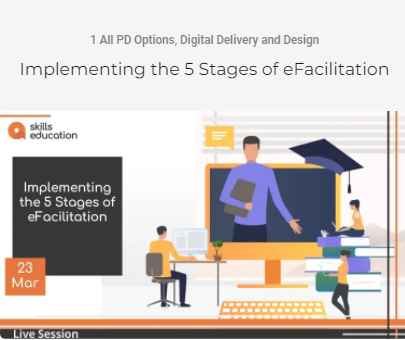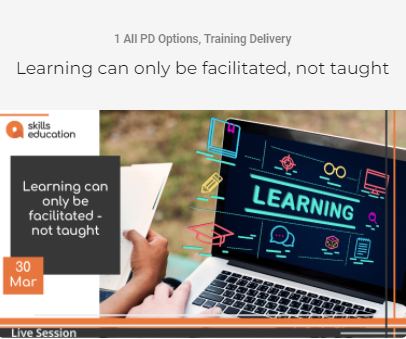Strategies for engaging adult learners - based on Jane GoodFellow's Engaging the unengaged webinar (via Velg Training) - 28 February 2022
Author:Allison W Miller
I was very lucky to attend the Engaging the unengaged webinar via Velg Training by Jane GoodFellow in late February, as even with over 20 years experience designing, developing and delivering training (15+ online) in the Vocational Education and Training (VET) sector, there were some real gems in Jane’s session.
Jane started by referring to the Universal Design for Learning (UDL), a framework which promotes motivation in students through access with an emphasis on digital learning tools.
UDL is a concept I have been learning more about recently after reading Kevin Kelly and Todd Zakrajsek’s book, Advancing online teaching: Creating equity-based digital learning environments.
Jane started her session by switching off her video so it doesn’t distract from the messages she had very well presented via her PowerPoint slides, so she also considered our cognitive load in her presentation style.
Jane then explained what is needed if educators are to engage students using the UDL framework, with the:
- Why? – Affective networks in students’ brains – ie gaining students’ interest, understanding their motivation to learn, and then getting them excited about their learning
- What? – Recognition networks in students’ brains – the place in the brain that stores and assigns meaning to the facts that they see, hear and read
- How? – Strategic networks in students’ brains – where students’ plan, organise and perform tasks through learning activities
Some ways to engage students include:
- creating curiosity and interest – by giving students choices, relevant work, skill building through games, and ensuring students get an opportunity to ‘move around’ while learning
- presenting content in different ways – using video, hands-on learning etc (see examples below)
- providing various ways for students to demonstrate what they have learned – making videos, drawing, using concept map etc
Jane provided us with an explanation of why we need to deliver training differently to our students based on the work of Joshua McCarthy (2010), which explains how some students prefer information to be provided in more visual and easy to consume modes eg Video / Visuals, just like when they interact with social media and professional online spaces.
This makes perfect sense when you consider how a lot of people consume information via short, sharp, and shiny video content which people can interact with. Jane provided this information via a QR code, which required participants to access via a QR code reader on their phone. This was a great technique for making helping people engage with the content.
The following are my notes of all of the tips and tools Jane, and the other webinar participants, provided during the session, together with a few of my own.
1. Agree on expectations
Be clear about your expectations of your students, and share these with your students visually and repeatedly. Make sure your expectations are fair and inclusive. Also ask students what their expectations are about their training so you know whether you need to manage their expectations about what the course offers, or whether you need to incorporate expectations you had not considered before.
2. Ensure accessibility
Accessibility means students being able to access content without effort. It also includes things like:
Presenting content in accessible ways
- ensuring you use Word/PDF for all content – Using Word 365, which has an Immersive Reader, allows people to ‘hear’ what is written on the page (and in different languages, if needed)
- providing content in at least two formats – hard and soft copies, closed captions or text script for videos
- turning on closed captions as this assists students with additional learning needs (which Jane did for this session)
- using Microsoft Stream 365 to store/create video as this provides closed captions and text scripts
- letting students know about Natural Readers website which allows students to upload text and documents which can then be converted to mp3 so they can listen anywhere anytime – https://www.naturalreaders.com/
- using easy to read, simple fonts eg Arial – simple fonts are also cheaper if you are printing hard copies as they use less ink
- using cartoons to portray messages as they are easier on the brain to process
- if you do use images, then keep the images simple, and ensure your images have Alt text/tags so screen readers can ‘narrate’ what the image is
Colour
- using black font on a white background is the best colour combination to process information
- limit colour to one or two colours on a PowerPoint slide
Chunk up the content
- TED talks are only 18 mins in length for a very good reason as this is the optimum time for processing information
- using infographics to demonstrate complex information:
- PiktoChart is free – https://piktochart.com/
- Scratch – https://scratch.mit.edu/
- using different PowerPoint slide ‘transitions’ to mix things up
- using synchronous and asynchronous activities eg asynchronous activities between live (synchronous) sessions such as getting students to watch videos in their own time eg TED Talks or undertaking a Crash Course – https://thecrashcourse.com/
3 Using social media based learning strategies (note – this is not using social media for learning, but using the strategies that social media sites use to engage people, eg:
- TikTok – is an accessible social media site which provides short, sharp and shiny content (up to 3 mins) which could be used for learning ie keep content short
- using stories which trigger an emotional response in your students
- using relevant questions for your target audience – questions to reflect and connect to their own lives
- Sense of humour – make things fun
- Contrary point of view
- Compelling storytelling
- Newsworthy content and updates
- A consistent presence – regularly updating content, or sending a Poll between classes
- Mix of content topics and formats
- Include a call to action – what do students need to do next?
- Using social media based apps – Ziplet (polling), Flipgrid (Video discussion board ie an educational ‘TikTok’ type experience – also has an Immersive Reader), Jamboard (interactive whiteboard), Google Hangout (Messenger app), ClassClicker (polling)
4 Gamification – using the strategies that Game developers use to ‘hook’ their users, eg healthy competition, rewards and instant feedback
- True/False as a physical quiz in a classroom where students move from one location or by putting up their hands up
- Trainer vs Class activities where the students get a point or a ‘free’ minute if they get things right and ‘beat the trainer’
- Kahoot! – the leader boards encourage some healthy competition
- Pick a box – SlideLizard – get Copyright approved content on a slide with questions/ comments as it allows students to have a choice
- Would you rather? – Ask students if they would rather … 2 hr lecture or 2 hr learning ‘quest’ – this good for physical or online training, and again provides students with a choice
What to do next?
Improving your students’ engagement starts with focussing on one area of your teaching which can be improved based upon on your observation of your students, or by asking your students what ways they like to learn (choice).
For me, I am going to try using QR codes for content which is too text heavy for a PowerPoint slide.
What about you?
Want to hear more from me?
Join me for these two great webinars that I am running in collaboration with Skills Education:
Register for both and you get a discount: https://www.skillseducation.com.au/bundles/facilitating-learning
References:
McCarthy, J. 2010. Blended learning environments: Using social networking sites to enhance the first year experience, Australasian Journal of Educational Technology, 26(6), https://doi.org/10.14742/ajet.1039
Kelly, K. & Zakrajsek, T. 2021. Advancing online teachnig: Creating equity-based digital learning environments, Stylus Publishing, Sterling, Virginia – https://styluspub.presswarehouse.com/browse/book/9781620367223/Advancing-Online-Teaching



